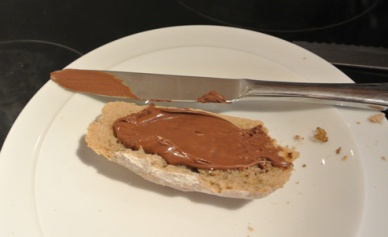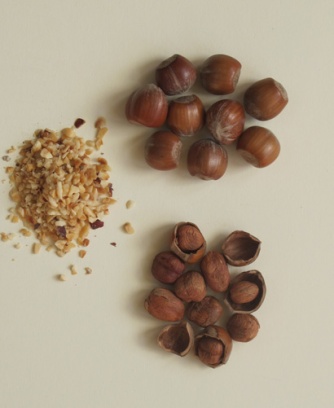Week 7 of the Bakeoff was dessert week, and Mary took the opportunity to set the bakers an unfamiliar technical challenge – Marjolaine. This decadent French cake is made from layers of nutty meringue, called dacquoise, separated by chocolate ganache and hazelnut praline all topped with chopped almonds, hazelnuts and pistachios. In this series of wanderings through the chemistry of the Bakeoff we have encountered some of these ingredients before, but hazelnuts have not yet featured and the central role they played this week certainly earns them a more detailed discussion.
Hazelnuts are a popular ingredient in sweet dishes and confections. Praline is made by setting hazelnuts into caramel and then blending into a powder which can be added to cakes, puddings or chocolates. Viennese hazelnut torte is made using hazelnut paste, while Kiev cake can be made using a meringue flavoured with hazelnut flour.

Hazelnut chocolate spread on bread
Perhaps the most popular use of hazelnuts is in nutty chocolate spreads, widely eaten on toast for breakfast or as a snack – or even eaten simply with a spoon by the most enthusiastic! This now abundant product may have surprisingly humble origins – it may have been invented by a confectioner adding hazelnuts to chocolate in order to save money during World War II rationing.
The nuts are often roasted to improve their flavour and storage life, a practice which goes back millennia. In 1995 a pit was unearthed on the Scottish island of Colonsay containing the remains of thousands of burnt hazelnut shells which were revealed by radiocarbon dating to be around 9,000 years old. Raw hazelnuts are rich in protein, fat and a number of important nutrients such as vitamin E and manganese; this may account in part for their use in breakfast cereals.
A recent paper used the advanced analytical technique of 2-dimensional gas chromatography, or GCxGC, alongside mass spectrometry and olfactometry (human smell testing) to quantitatively investigate the chemical compositions of raw and roasted hazelnuts and to see which are responsible for the distinctive aromas of the nuts. We will first look at the results to understand why the bakers in the tent took the time to roast their nuts, before a short summary of how the analytical techniques used in the study work.

The four key compounds responsible for the smell of raw hazelnuts
Raw hazelnuts contain a large number of volatile small molecules, but only four above the minimum concentration (“odor threshold”, or “OT”) detectable by a human nose. All four of these, depicted right, are present at higher concentrations in the roasted nuts, but the biggest change is likely to be due to the formation of a further fourteen odorants. The paper describes these additional compounds as having a range of scents from “popcorn-like” to the rather less appetizing “sweaty”. The molecular diagrams below show that while the scent of raw hazelnuts is largely due to linear molecules, the roasted nut aroma can also be attributed to small cyclic molecules (shown below). Molecules of this type are are typical products of thermal degradation of sugars and proteins.

A small selection of the molecules present in the aroma of roasted hazelnuts
Gas chromatography (GC) is a widely used analytical technique for separating a mixture of many chemical components into “fractions” by passing the mixture through a column. The components travel at different speeds depending on their chemical character and so the mixture separates – a more detailed discussion can be found in our page about lavender. In comprehensive two-dimensional gas chromatography, GCxGC, the mixture is passed through a column which then feeds into a series of secondary columns each of which has its own detector. These secondary columns are different from the first in some way – they may have a different chemical “stationary phase” or be at a different temperature. This is to allow effective separation of components which appear very similar in the first column, allowing high resolution separation. Each column may also be coupled to a mass spectrometer (“GCxGC-MS”) for accurate identification of each product, just like in normal GC-MS. A thorough discussion of GCxGC, including its applications in food science, is given in this review article and several others like it.

Whole, cracked and chopped hazelnuts
Smells are not quite as simple as being the sum of the smells of their component chemicals, as shown in the paper by the researchers trying to imitate the smells by combinations of the aroma compounds they found in their analyses. They found that the smell of raw hazelnuts could be replicated using the four components above and hexanal, which was also found in the nuts but thought to be at too low a concentration to be detectable by the nose. However for roasted hazelnuts the smell was replicated exactly by the compounds found in the experiment at their natural concentrations.
This goes some way to showing how developments in analytical chemistry continue to develop our understanding of what makes our favourite foods so delicious. While the bakeoff contestants do, from time to time, bring in home-made gadgets to aid their cooking efforts, we may have to wait a while to see anyone setting up a laboratory in the tent.
Contributors: Harry Morgan (writing), Natalie Fey (images)


Pingback: Summer Projects | Fey Group Webpages